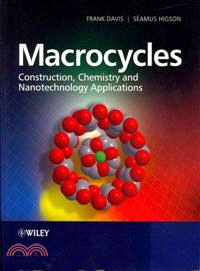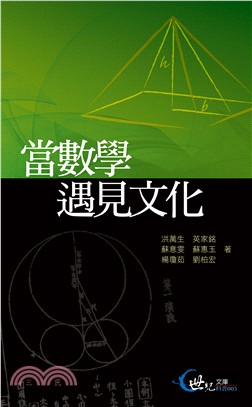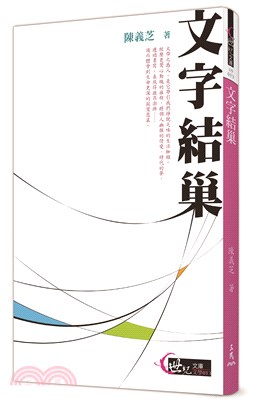Macrocycles - Construction, Chemistry And Nanotechnology Applications
商品資訊
ISBN13:9780470714638
出版社:John Wiley & Sons Inc
作者:Higson
出版日:2011/03/25
裝訂/頁數:平裝/608頁
規格:23.5cm*18.4cm*3.2cm (高/寬/厚)
商品簡介
Macrocycles: Construction, Chemistry and Nanotechnology Applications is an essential introduction this important class of molecules and describes how to synthesise them, their chemistry, how they can be used as nanotechnology building blocks, and their applications. A wide range of structures synthesised over the past few decades are covered, from the simpler cyclophanes and multi-ring aromatic structures to vases, bowls, cages and more complex multi-ring systems and 3D architectures such as “pumpkins”, interlocking chains and knots. Topics covered include:
- principles of macrocycle synthesis
- simple ring compounds
- multi-ring aromatic structures
- porphyrins and phthalocanines
- cyclophanes
- crown ethers, cryptands and spherands
- calixarenes, resorcinarenes, cavitands, carcerands, and heterocalixarenes
- cyclodextrins
- cucurbiturils
- cyclotriveratylenes
- rotaxanes
- catenanes
- complex 3D architectures, including trefoils and knots
Macrocycles: Construction, Chemistry and Nanotechnology Applications distills the essence of this important topic for undergraduate and postgraduate students, and for researchers in other fields interested in getting a general insight into this increasingly important class of molecules.
作者簡介
Cranfield University, UK
Dr Davis is a research fellow at Cranfield University, specialising in the biochemical and supramolecular aspects of electrochemistry. As well as pursuing academic research he has undertaken contract research for organisations such as Unilever Research (Port Sunlight), ITM Power Ltd (Sheffield), Timestrip (Hitchen) and DEFRA, and spent a 4-year research post within Gillette UK
Professor Seamus Higson
Cranfield University, UK
Seamus Higson is Professor of Bio- and Electro-Analysis at Cranfield University which he joined in August 2002. His previous career spans academic departments of chemistry, medicine and materials science and this is reflected in his research. Professor Higson also serves within an advisory and / or consultative capacity for a number of public bodies and also acts as Technical Director for Microarray Ltd - a company formed upon science and patents originating from his group. His current research is primarily focussed towards practical implementation of electro analytical science and analytical biochemistry for biomedical, environmental and industrial process control applications.
目次
1. Introduction.
1.1. Simple ring compounds.
1.2. Three dimensional aliphatic carbon structures.
1.3. Annulenes.
1.4. Multi-ring aromatic structures.
1.5. Porpyrins and phthalocanines.
1.6. Conclusions.
References.
2. Cyclophanes.
2.1. Introduction to cyclophanes.
2.2. Cyclophanes with one aromatic system and aliphatic chain.
2.3. Cyclophanes with more than 1 aromatic ring.
2.4. Napthalenophanes and other aromatic systems.
2.5. Cyclophanes containing heteroaromatic systems.
2.6. Ferrocenophanes.
References.
3. Crown ethers, cryptands and other compounds.
3.1. Introduction.
3.2. Crown ethers.
3.3. Simple complexes with crown ethers.
3.4. Azacrowns, cyclens and cyclams.
3.5. Crowns containing other heteroatoms.
3.6. Lariat and bibracchial crown ethers.
3.7. Cryptands.
3.8. Spherands.
3.9. Combined and multiple systems.
3.10. Applications of crown ethers and related compounds.
3.11. Conclusions.
References.
4. Calixarenes.
4.1. Introduction to calixarenes.
4.2. History of the calixarenes.
4.3. Structures of calixarenes.
4.4. Chemical modification of calixarenes.
4.5. Complexes with calixarenes.
4.6. Bis- and multicalixarenes.
4.7. Oxacalixarenes, azacalixarenes and thiacalixarenes.
4.8. Resorcinarenes - synthesis and structure.
4.9. Cavitands and carcerands.
4.10. Uses of calixarenes and conclusions.
References.
5. Heterocalixarenes and calixnaphthalenes.
5.1. Introduction to heterocalixarenes and calixnaphthalenes.
5.2. Calixnaphthalenes.
5.3. Tropolone based macrocycles.
5.4. Calixfurans.
5.5. Calixpyrroles.
5.6. Calixindoles, calixpyridines and calixthiophenes.
5.7. Conclusions.
References.
6. Cyclodextrins.
6.1. Introduction to cyclodextrins.
6.2. Complex formation by cyclodextrins.
6.3. Cyclodextrins of other sizes.
6.4. Modification reactions of cyclodextrins.
6.5. Selectivity of cyclodextrins.
6.6. Multiple cyclodextrin systems.
6.7. Polymeric cyclodextrins.
6.8. Cyclodextrins combined with other macrocyclic systems.
6.9. Therapeutic uses of cyclodextrins.
6.10. Other uses of cyclodextrins.
6.11. Conclusions.
References.
7. Cyclotriveratylenes and cryptophanes.
7.1. Introduction to cyclotriveratrylenes and cryptophanes.
7.2. Synthesis of cyclotriveratrylenes.
7.3. Modification of cyclotriveratrylenes.
7.4. Synthesis of optically active cyclotriveratrylenes.
7.5. Modification of the bridging groups.
7.6. Modification of the aromatic rings with organometallic groups.
7.7. Selective binding applications of cyclotriveratrylenes.
7.8. Analogues of CTV.
7.9. Cryptophanes - synthesis and structure.
7.10. Cryptophanes - chemical modification.
7.11. Complexes with cryptophanes.
7.12. Cryptophane/Xenon complexes.
7.13. Other uses of cryptophanes.
7.14. Hemicryptophanes.
7.15. Conclusions.
References.
8. Cucurbiturils.
8.1. Introduction to cucurbiturils.
8.2. Complexation behaviour of simple cucurbiturils.
8.3. Modification of cucurbiturils.
8.4. Uses of cucurbiturils.
8.5. Hemicucurbiturils.
8.6. Conclusions.
References.
9. Rotaxanes and catenanes.
9.1. Introduction to rotaxanes and catenanes.
9.2. Rotaxanes.
9.3. Rotaxanes as molecular machines.
9.4. Thin films of rotaxanes.
9.5. Polyrotaxanes.
9.6. Catenanes.
9.7. Switchable catenanes.
9.8. Catenanes on surfaces.
9.9. Polycatenanes and catenated polymers.
9.10. Natural catenanes.
9.11. Conclusions.
References.
10. Other supermolecular systems, molecular motors, machines and nanotechnological applications.
10.1. Introduction.
10.2. Other molecular systems.
10.3. Molecular devices, motors and machines.
10.4. Conclusions.
References.
主題書展
更多書展本週66折
您曾經瀏覽過的商品
購物須知
外文書商品之書封,為出版社提供之樣本。實際出貨商品,以出版社所提供之現有版本為主。部份書籍,因出版社供應狀況特殊,匯率將依實際狀況做調整。
無庫存之商品,在您完成訂單程序之後,將以空運的方式為你下單調貨。為了縮短等待的時間,建議您將外文書與其他商品分開下單,以獲得最快的取貨速度,平均調貨時間為1~2個月。
為了保護您的權益,「三民網路書店」提供會員七日商品鑑賞期(收到商品為起始日)。
若要辦理退貨,請在商品鑑賞期內寄回,且商品必須是全新狀態與完整包裝(商品、附件、發票、隨貨贈品等)否則恕不接受退貨。
























